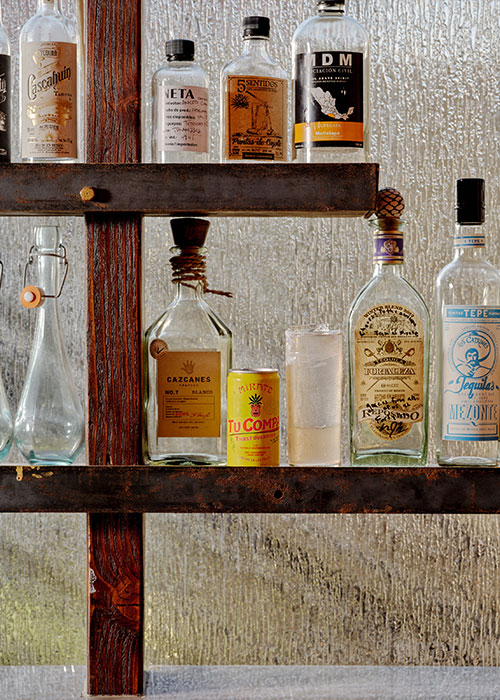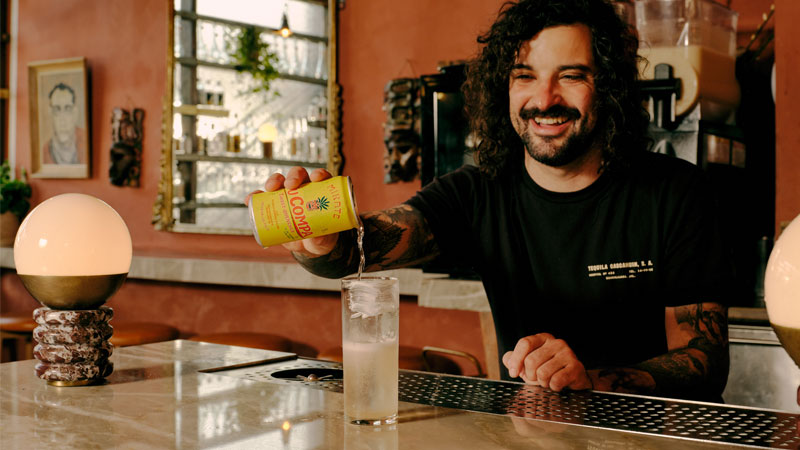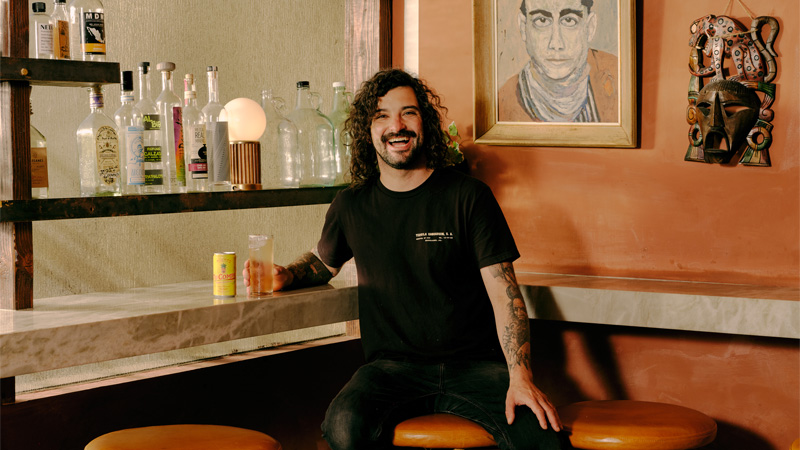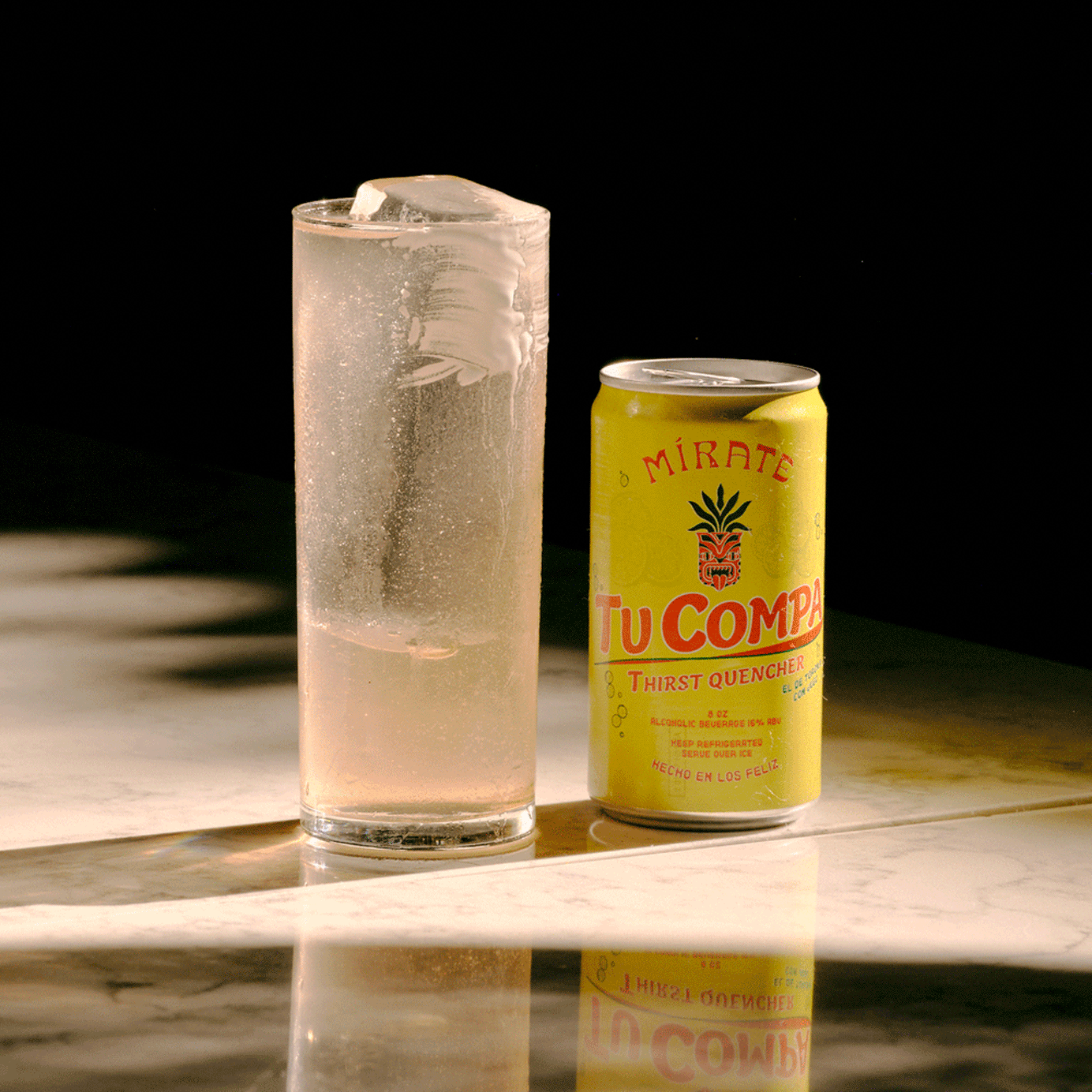As beverage director of acclaimed Los Angeles restaurant and agave bar Mírate, Max Reis has had plenty to smile about — and the man smiles a lot. The venue, co-owned by restaurateur Matthew Egan and chef Joshua Gil, landed on North America’s 50 Best Bar list in April. Last fall, VinePair’s Next Wave Awards crowned the venue Food and Beverage Program of the Year. These plaudits, a veteran presence in the L.A. bar scene, and years spent advocating for producers creating tequila and mezcal in traditional ways, reinforce Reis’ status as one of the cocktail world’s foremost authorities on all things agave. One of the finest examples of this mastery is Mírate’s whimsical, intensely technical, and all-around bonkers interpretation of the Paloma.
The Tu Compa (which translates to “your best friend” in English, even though its pronunciation is cheekily spelled out “puh-loh-muh” on Mírate’s menu) is refreshing and delicious, but it’s also deviant. It doesn’t simply call for tequila, lime juice, and grapefruit soda. Instead, Mexican sake, pulque, pomegranate liqueur, and a house-made version of grapefruit soda Squirt are involved in the mix. In other situations, this recipe may border on sacrilege, given how serious Southern California residents are about using Squirt in their Palomas. In Reis’ hands, though, it’s a must-have. It’s a good thing, too: It takes Reis three days to make each Tu Compa batch, which yields 65 servings. The drink’s quality needs to be worthy of such a massive undertaking.
So, how does Mírate turn a basic drink into a complex cocktail of epic proportions? We caught up with Reis and asked him to take us behind the scenes of his play on the Paloma.
Step One: Prepare the Cordial
Reis’ house-made Squirt cordial is arguably the drink’s most critical ingredient. Squirt is the Paloma’s soul for many L.A. residents, and it has clout in Mexico, too: Walk into a cantina, and there’s a more than likely chance that crates of the soda both unused and discarded will be present. It’s a bit of a bold move to create a cordial that mimics its flavor, as locals would likely know if it fell short. But Reis pulls it off through meticulous prep work. It’s especially impressive considering beverages like Squirt aren’t really Reis’ thing.
“I’m not a soda guy,” Reis explains. “We just wanted to use all natural ingredients [in the cordial] and call it ‘Squirt.’”
He begins making the cordial by clarifying grapefruit juice, a process that intensifies its acidity. He stirs in enzymes (Pectinex, Kieselsol, and Chitosan, to get really technical) into the juice in 15-minute intervals before giving the mix a spin in a Booker & Dax Spinzall centrifuge.
“Some juices don’t always separate from fruit that well,” Reis explains. “These natural chemicals assist in that breaking process.” He then pumps out the juice and strains the residual purée from the centrifuge’s reservoir to nab every last drop of liquid before storing what he’s collected in the fridge.
To finish the cordial, Reis pours the juice into a Vitamix and sets the machine at one-third speed, gradually pouring in an equal amount of sugar and a relatively modest amount of salt. He also acid-adjusts the juice by adding malic and citric acids to amplify intensity.
“It doesn’t taste like grapefruit soda without it,” Reis notes. “Think of it as adding the acidity of lime juice but eliminating the lime flavor.” He then blends it on high for 90 seconds and runs the mix through his fingers when pouring to detect rogue granules. If he finds any, he repeats the process in 30-second intervals until they’re completely gone.
Step Two: Sous Vide
Next, Reis transfers the grapefruit juice blend into a sous vide bag, where grapefruit peels await to imbue further complexity.
“I was at this bar in Guadalajara called De La O, and they had this drink on the menu called a Pulque Paloma. It was rustic and completely pulque-forward. The thought of using pulque in a Paloma had been floating around in my head ever since.”
“The grapefruit peels contain grapefruit oil, which adds another layer of flavor to the process,” Reis explains. “Plus, using the peels this way is a nice way to minimize waste in the process.” Reis sous vides the blend at 135 degrees Fahrenheit for two hours, fine-strains it, and stores the batch in the refrigerator, where it keeps well for up to a month — primed and ready for future Palomas. And there are plenty of leftovers, since each cordial batch yields 200 servings.
Step Three: Batch
The careful construction of the Squirt cordial sets the table for the rest of the Tu Compa’s build, which also takes place behind the scenes and gets repeated every two to three days before service begins. Reis chose Cascahuin 48 for the drink’s tequila because he’s a fan of its traditional, land-honoring distillation process, but also because it checks in at 96 proof — much higher than the 80 proof typically associated with tequila. Reis notes the higher proof makes it possible to incorporate more layers of flavor to the drink without losing the spirit’s grassy, vegetal qualities. He takes advantage of this in a handful of ways.
Take the inclusion of pulque, an alcoholic beverage made from fermented agave sap. Its umami notes play nicely with Caschahuin, but it also gives Reis the opportunity to act on an idea he picked up on the road in Mexico.
“The bitterness of the pomegranate naturally piggybacks on the bitterness of the grapefruit and gives off such a great bitter finish. It also gives the drink this beautiful light pink hue.”
“I was at this bar in Guadalajara called De La O, and they had this drink on the menu called a Pulque Paloma,” he says. “It was rustic and completely pulque-forward. The thought of using pulque in a Paloma had been floating around in my head ever since.”
Reis complements the pulque with junmai ginjo sake from Nami, a Sinaloa-based sake brewery and Mexico’s first-ever sake producer. The sake’s barnyard funk creates harmony with the pulque’s savory essence to add further depth to the drink. He also adds a touch of Granada Vallet, a pomegranate liqueur known for its aggressive bitter notes.

“The bitterness of the pomegranate naturally piggybacks on the bitterness of the grapefruit and gives off such a great bitter finish,” Reis says. “It also gives the drink this beautiful light pink hue.”
Since it’s a batched drink, the ratios Reis uses in the process are sizeable: 2,000 milliliters each of tequila and the reserved Squirt cordial; 1,000 milliliters each of pulque and sake; and 500 milliliters of Granada Vallet, all topped off with 9,000 milliliters of water. He combines the ingredients in a 20-liter container, stirs, and stores in the fridge for service.
Step Four: Carbonate
Carbonation is essential to a proper Paloma. The addition of carbon dioxide concentrates the drink’s flavors and makes them more pronounced. Without carbonation, a would-be Paloma is simply a grapefruit cocktail.
Naturally, carbonation plays a key role in the Tu Compa’s success, and Reis gives the process the studious attention you’d expect. After chilling the entire reserved batch to around 20 to 23 degrees, Reis fills a soda bottle roughly halfway with some of the mix. He then squeezes the bottle to displace the air inside and refills the bottle with carbon dioxide using a CO2 tank, shaking the bottle so that the gas gets distributed evenly. Next, he closes the bottle and reopens it 20 minutes later, purging any bubbles that may have formed along the way. He repeats this process three times with each batch before putting it in the fridge overnight to be served to guests the following day.
Step Five: Can
After the batch has been refrigerated overnight, Reis finishes off the process by canning the drinks to help keep the carbonation fully intact, a move he learned from fellow L.A. bar Thunderbolt, which also cans its carbonated cocktails. To Reis, the tactic symbolizes the camaraderie that exists within the local drinks landscape.

“One of the things I love about the L.A. bar scene is that we all throw each other bones. We don’t gatekeep,” he says. “We want to make sure the scene is constantly growing.”
The one-two punch of carbonation and canning is a two-day process and occurs every time Reis creates a batch. It gets the drink close to the finish line, but it doesn’t quite cross it yet.
Step Six: Paint
There are a couple other tricks Reis pulls out to complete the Tu Compa. After a guest orders one, he slathers each glass’s rim with what he calls “pulque paint,” a streak of salted pulque that’s thickened with food starch and dyed white with titanium dioxide. “It almost looks like Elmer’s Glue,” he says.
Step Seven: Spray
He also hits the top of the empty glass with a mixed spray of culinary-grade grapefruit essential oil and food-grade ethanol, a tactic that mimics the expression of oil from a grapefruit peel.
“The spray gives the drink freshness,” Reis says. “It helps bring a peel’s essential oils to your face when you drink it.”
Step Eight: Serve

Servers open the can and pour its contents into the waiting glass in front of guests. The can’s yellow hue, red lettering, and “Thirst Quencher” label — all visual hallmarks of a traditional Squirt can — make it an obvious parody, but it’s also a nod and a wink to L.A.’s devotion to the soda.
Making the Tu Compa is, in short, arduous and time consuming. But Reis doesn’t mind the effort. He knows he’s creating an intentionally elaborate take on a simple beverage. “At the end of the day, it’s just a simple Mexican highball,” he says. “It’s an unfussy drink. Ours just happens to be fussy.”
